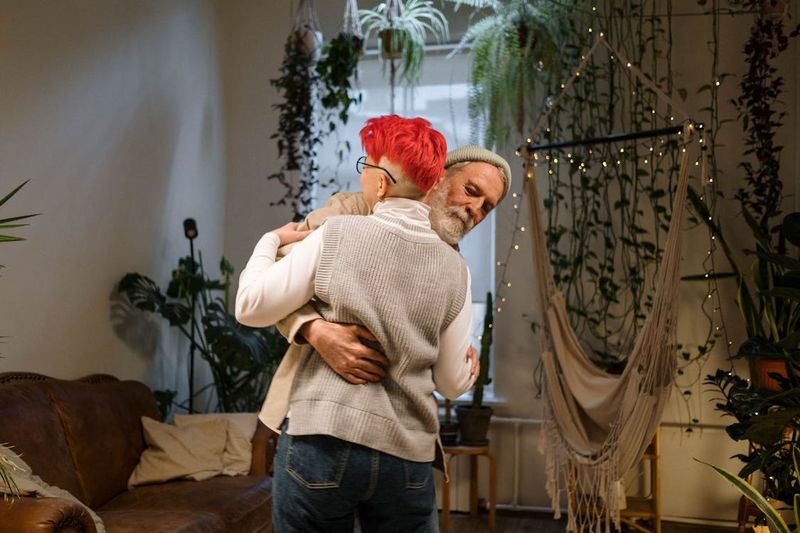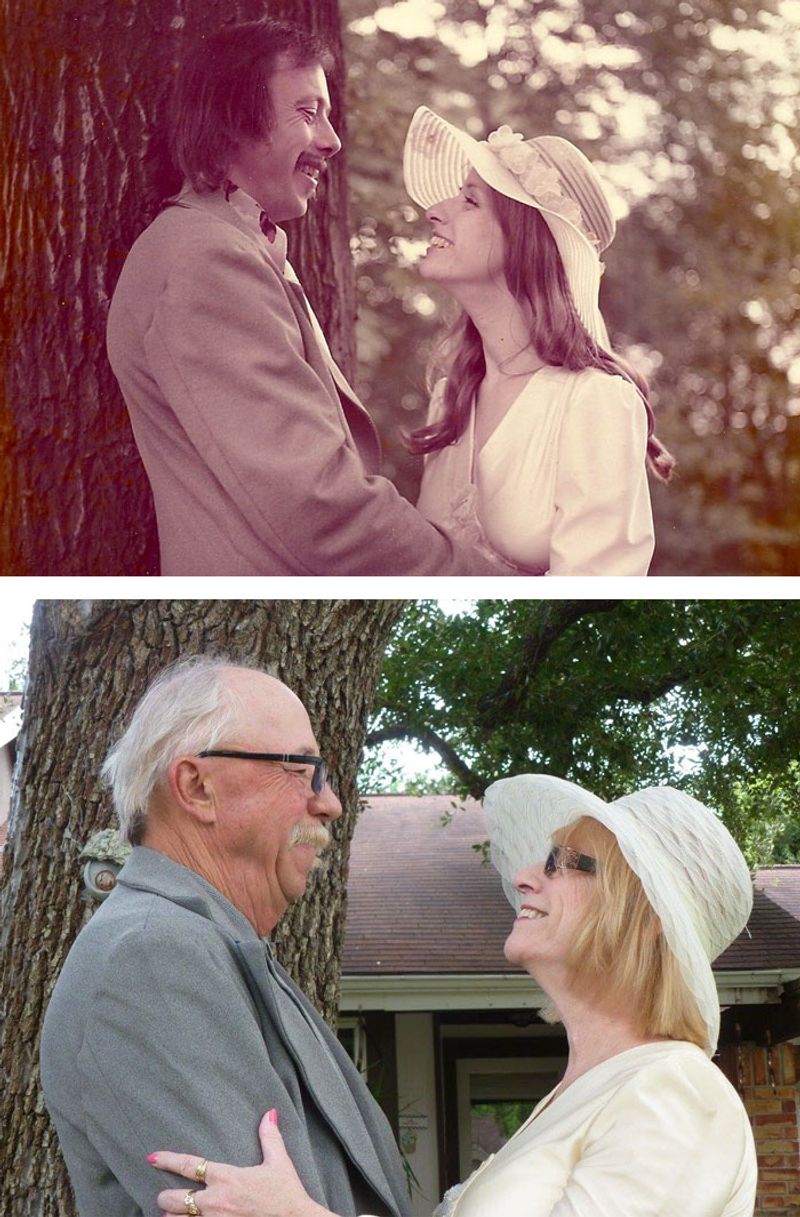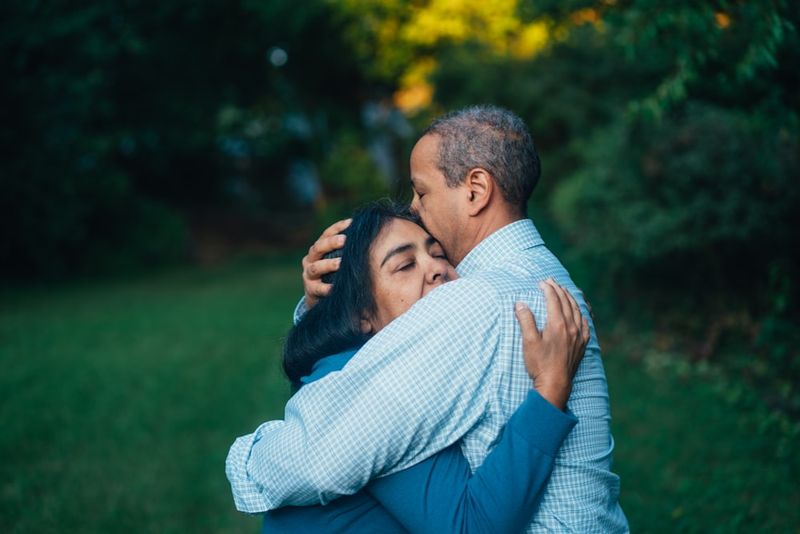20 Reasons Couples Grow Apart After 30+ Years
In the tapestry of life, love stories often evolve in ways that are both beautiful and bittersweet. When couples journey through life together for over three decades, subtle shifts can occur, often unnoticed, which may cause them to drift apart.
The reasons are many, complex, and deeply personal, reflecting the nuanced nature of human relationships.
This post explores reflective and emotionally grounded reasons why such separation might happen, offering insights into the quiet transformations that can change the course of long-term partnerships.
1. They stop sharing new experiences together

Shared experiences are the glue that binds couples together, creating moments of connection and joy. As life progresses, the eagerness to explore new adventures together may fade. Routine becomes the norm, overshadowing the excitement of discovering new paths side by side.
The couple who once traveled to unknown places, or tried new hobbies, might find themselves stuck in repetition. Dining at the same restaurant, following the same daily rituals, these routines can stifle personal growth and shared joy. Over time, this lack of novelty can fray the emotional ties that bind them.
Yet, it’s never too late to rekindle that spirit of exploration. Trying a new class together or planning an impromptu weekend getaway can reignite the spark. The key is to seek out fresh experiences that can breathe life back into the relationship, nurturing the bond that has grown between them over the decades.
2. Grief shifts the emotional landscape

Grief is a profound emotion that can reshape the inner landscape of a relationship. When a loved one is lost, the grieving process can be isolating, causing partners to retreat into their own worlds. The embrace of shared sorrow can be elusive, as each person copes in their unique way.
The once vibrant connection may fade into silence, as unspoken pain lingers in the air. Emotional withdrawal can lead to a widening gap, separating partners who once shared everything. Conversations become stilted, overshadowed by the weight of unexpressed feelings and memories.
Finding solace in each other requires patience, understanding, and compassion. Walking through grief together can deepen the connection, transforming sorrow into a shared journey. By opening up and expressing vulnerability, couples can navigate this challenging path hand in hand, rediscovering the strength and comfort of their bond.
3. They evolve in different directions—without checking in

Life is a journey, and along the way, people grow and change. Sometimes, partners evolve in different directions, pursuing passions or careers that lead them down separate paths. Without regular check-ins, this divergence might go unnoticed, creating an emotional distance.
One partner may seek new challenges, while the other craves stability and routine. This imbalance can lead to feelings of neglect, as if their dreams and desires no longer align. Over time, the gap widens, with each partner feeling misunderstood or unheard.
Reconnecting requires active communication and mutual support. By regularly sharing dreams, fears, and aspirations, couples can navigate these changes together. Embracing each other’s growth allows the partnership to flourish, turning potential drifting apart into a harmonious journey of shared exploration.
4. The house gets quieter, but so does connection

As children grow up and leave the nest, the once-busy household becomes quieter. While this tranquility can offer peace, it may also lead to an unsettling silence. The absence of noise can echo the diminishing connection between partners.
Daily interactions may become sparse, as the couple enjoys the newfound calm. However, this silence can hide unspoken emotions and unmet needs. The shift in dynamics can create a feeling of emptiness, where the lively conversations and laughter once thrived.
To combat this quiet drift, couples can cultivate new rituals of connection. Whether it’s a weekly date night, shared hobby, or simply enjoying a sunset walk, these moments can foster communication and intimacy. By filling the silence with intentional connection, partners can rediscover the joy of companionship that once filled their home.
5. One partner wants to slow down, the other speeds up

As time passes, individual energy levels and aspirations may shift. One partner might wish to slow down, savoring life’s simple pleasures, while the other seeks excitement and activity. This divergence in pace can create tension, pulling them in different directions.
The partner eager to explore may feel frustrated by the other’s reluctance to keep up. Conversely, the one who prefers calm may view the other’s enthusiasm as overwhelming. These differing rhythms can lead to feelings of disconnection, as each partner struggles to reconcile their desires.
Finding balance requires empathy and compromise. By understanding each other’s needs and adjusting expectations, couples can find a harmonious rhythm. Whether it’s planning activities that cater to both paces or taking turns leading the way, embracing these differences can strengthen the relationship, creating a more fulfilling journey together.
6. Old resentments outgrow their hiding places

Over the years, unresolved issues and resentments may become buried beneath the surface of a relationship. What starts as minor disagreements can grow into larger rifts, hidden away but never truly gone. As time passes, these old wounds may resurface, demanding attention.
The buildup of unresolved tensions can create an emotional chasm, leading to misunderstanding and bitterness. Partners may find themselves trapped in a cycle of blame, unable to move past the grievances of the past. This lingering resentment can erode trust and affection, slowly driving them apart.
Healing requires courage and open dialogue. By addressing past hurts and seeking forgiveness, couples can begin to mend the fractures in their relationship. Embracing vulnerability and empathy allows partners to reconnect on a deeper level, transforming old resentments into opportunities for growth and renewed understanding.
7. Physical intimacy becomes a topic neither wants to bring up

Intimacy plays a crucial role in maintaining a loving connection, yet it can become a challenging topic as couples age. The physical changes that come with aging, combined with long-standing relationship dynamics, may lead to reluctance in discussing physical needs and desires.
This avoidance can create a barrier, with both partners feeling neglected or unfulfilled. The once open and passionate aspect of their relationship might become a source of discomfort or misunderstanding. In time, this lack of communication can lead to feelings of isolation and emotional distance.
Reviving intimacy requires openness and sensitivity. By approaching the topic with honesty and compassion, couples can rediscover the joys of physical connection. Exploring new ways to connect, whether through touch, words, or shared experiences, can reignite the spark, fostering a deeper sense of closeness and trust.
8. Friendships pull them in opposite directions

Friendships enrich our lives, providing companionship and support beyond romantic relationships. However, as couples age, their social circles can sometimes pull them in differing directions, creating a subtle divide.
One partner may become engrossed in a new group of friends, while the other feels left behind or disconnected. This shift in social dynamics can lead to feelings of exclusion and jealousy, as partners spend more time apart. The shared experiences that once united them may become overshadowed by individual pursuits.
Balancing friendships and partnership requires understanding and collaboration. Encouraging each other’s social endeavors while also nurturing shared friendships can bridge the gap. By finding ways to integrate social lives or introducing each other to new circles, couples can maintain a strong connection while enjoying the richness that diverse friendships offer.
9. Retirement introduces unexpected friction

Retirement is often viewed as a time of relaxation and new beginnings. However, it can also bring unexpected challenges, as couples adjust to spending more time together. The transition from structured work life to shared daily routines may lead to friction.
One partner might embrace newfound freedom, while the other struggles with the lack of routine or purpose. This adjustment period can reveal differing expectations and unspoken desires, leading to misunderstandings or conflicts. The dream of a harmonious retirement may become clouded by unanticipated tension.
Navigating this new phase requires open communication and flexibility. By discussing goals, interests, and concerns, couples can align their visions for retirement. Finding activities that satisfy both partners and setting aside personal space can help ease the transition, transforming potential friction into an opportunity for growth and renewed connection.
10. There’s less laughter—and no one notices at first

Laughter is the music of a loving relationship, a joyous expression that bonds partners. As years pass, the spontaneous humor that once filled a couple’s life may gradually fade, unnoticed. The absence of laughter can signify deeper emotional shifts, quietly marking the distance between them.
Without the shared joy of laughter, daily interactions may become mundane, lacking the light-heartedness that once sparked delight. Conversations may feel routine, missing the playfulness that once defined their connection. Over time, this subtle change can create an emotional void.
Rekindling laughter requires intentional effort. Finding humor in everyday moments, revisiting shared jokes, or exploring new comedic experiences together can revive this essential element. By seeking out joy and embracing playfulness, couples can rediscover the warmth and closeness that laughter brings, renewing the vibrancy of their relationship.
11. They stop being curious about each other

Curiosity fosters connection, as partners continually learn and grow together. Over time, assumptions about each other’s thoughts and desires may replace the inquisitive nature that once defined the relationship. This lack of curiosity can lead to stagnation and distance.
When partners stop seeking to understand each other’s evolving perspectives, they may miss out on the richness that growth brings. Conversations become shallow, and the depth of connection may wane. The once vibrant exchange of ideas and dreams fades into familiarity.
Reviving curiosity involves active engagement and empathy. By asking questions, showing interest in each other’s experiences, and exploring new topics together, couples can reignite the spark of curiosity. This renewed interest can deepen understanding and appreciation, strengthening the bond that has weathered time.
12. Everything becomes “just how it is”

Over decades, routines and habits may harden into unchanging patterns, creating a life that feels static. The phrase “just how it is” may become the mantra, as couples settle into comfortable rhythms that lack spontaneity or excitement.
This acceptance of routine can lead to complacency, dulling the vibrancy of the relationship. The once dynamic partnership may feel stagnant, as both partners resign themselves to a life without novelty or change. This sense of inevitability can mask unfulfilled desires and dreams.
Breaking free from routine requires a willingness to embrace change and seek new experiences. By challenging the status quo and exploring different paths, couples can breathe new life into their relationship. Whether through travel, learning, or simply shaking up daily routines, rediscovering the joy of spontaneity can reignite passion and connection.
13. They forget to ask how the other person is really doing

Life’s demands often overshadow intimate conversations, leading partners to neglect the simple question, “How are you really doing?” Over time, this omission can erode emotional intimacy, leaving partners feeling unseen or unheard.
In the rush of daily life, checking in may become a formality rather than a genuine inquiry. The depth of connection may suffer, as partners miss opportunities to share their inner worlds. This lack of emotional engagement can lead to feelings of isolation, slowly driving them apart.
Reestablishing this connection requires mindfulness and intentionality. By creating space for meaningful conversations and truly listening to each other, couples can nurture emotional intimacy. These simple yet profound exchanges can renew the bond, allowing partners to feel valued, understood, and cherished as they navigate life’s journey together.
14. Communication becomes more functional than emotional

As relationships mature, communication may evolve into a practical exchange of information rather than an emotional connection. Conversations about logistics, schedules, or daily tasks may overshadow deeper discussions, creating a functional yet emotionally distant relationship.
The shift to functional communication can lead to a lack of understanding and empathy. Partners may feel as though their emotional needs are unmet, as the once open dialogue becomes a checklist of responsibilities. This pragmatic approach can create an invisible barrier, preventing deeper connection.
Bridging this gap requires intentional emotional engagement. By setting aside time for heartfelt conversations and expressing emotions openly, couples can restore the emotional richness that sustains their relationship. Embracing both the practical and emotional aspects of communication can foster a balanced, fulfilling connection.
15. They miss who the other used to be

Nostalgia can be a powerful emotion, evoking memories of who partners were when they first fell in love. Over time, changes in personality, interests, or appearance may lead to longing for the person they once knew. This longing can create a barrier, preventing them from appreciating who their partner has become.
The focus on past versions of each other can overshadow the present, leading to feelings of disappointment or unmet expectations. This backward glance may hinder growth and understanding, as partners cling to an idealized past.
Embracing the present requires acceptance and appreciation of change. By celebrating the journey and growth they’ve experienced together, couples can honor both the past and present versions of each other. This shift in perspective allows them to build a future grounded in love and acceptance, appreciating the unique journey they share.
16. One partner starts growing—alone

Growth is a natural part of life, yet when one partner begins to evolve independently, it can lead to feelings of exclusion or loneliness. Pursuing new interests or personal development without sharing the journey may create a divide, leaving the other partner feeling left behind.
This individual growth, while positive, can strain the relationship, as the couple’s paths diverge. The once shared trajectory may feel fragmented, with each partner experiencing life through different lenses. This separation can lead to feelings of isolation and misunderstanding.
Bridging this gap requires inclusion and encouragement. By sharing personal growth experiences and involving each other in new pursuits, couples can align their paths. Supporting one another’s evolution allows the relationship to grow in tandem, creating a richer, more fulfilling partnership that respects individual journeys.
17. They stop showing appreciation out loud

Appreciation is the expression of gratitude and recognition, a vital component of a healthy relationship. Over time, partners may take each other for granted, forgetting to acknowledge the small acts of kindness and love that sustain their bond.
The absence of verbal appreciation can lead to feelings of neglect or unworthiness. Partners may feel undervalued, as their efforts go unnoticed or unspoken. This silent drift can create an emotional distance, slowly eroding the connection that once thrived on mutual admiration.
Reviving verbal appreciation requires mindfulness and intentionality. By consciously expressing gratitude and acknowledging each other’s contributions, couples can reinforce their bond. Whether it’s a simple thank you or a heartfelt compliment, these expressions can reignite the warmth and affection that form the foundation of their relationship.
18. Love becomes a habit, not a feeling

Love, when nurtured, is a vibrant and dynamic force. However, over time, it can become a routine, losing its emotional depth and intensity. The relationship may continue out of habit, with partners going through the motions without truly connecting.
This shift from feeling to habit can create a sense of emptiness, as the once profound connection becomes a mere formality. Partners may feel trapped in a cycle of predictability, yearning for the emotional richness that once defined their love.
Rekindling love requires active engagement and intentionality. By seeking new ways to connect emotionally, whether through shared experiences or heartfelt conversations, couples can transform habit into feeling. Embracing the dynamic nature of love allows partners to rediscover the passion and joy that brought them together, renewing their commitment to each other.
19. They avoid hard conversations out of fatigue

Life’s challenges and the complexities of long-term relationships can lead to emotional fatigue. Partners may choose to avoid difficult conversations, fearing conflict or exhaustion. This avoidance can create a barrier, as unresolved issues linger beneath the surface.
The reluctance to engage in hard conversations can lead to misunderstandings and unmet needs. Over time, this avoidance may erode trust and intimacy, as partners drift apart without addressing the underlying issues that need attention.
Overcoming this fatigue requires courage and commitment. By approaching hard conversations with empathy and openness, couples can navigate conflicts constructively. Creating a safe space for dialogue allows partners to address their concerns, fostering a deeper understanding and connection. This willingness to engage can transform potential obstacles into opportunities for growth and renewed intimacy.
20. They stop choosing each other, one day at a time

Love is a daily choice, a commitment renewed with each passing moment. Over time, the conscious decision to choose each other may fade, replaced by complacency or routine. This gradual drift can create a sense of disconnection, as partners forget to prioritize their relationship.
The absence of intentional choice can lead to feelings of neglect or indifference. Without the active commitment to choose each other, the relationship may become stagnant, lacking the vibrancy and passion that once defined it.
Reviving this choice requires mindfulness and dedication. By consciously prioritizing each other and nurturing their bond, couples can reignite the spark that brought them together. Embracing the daily decision to choose love allows partners to cultivate a fulfilling and resilient relationship, grounded in mutual respect and affection.







